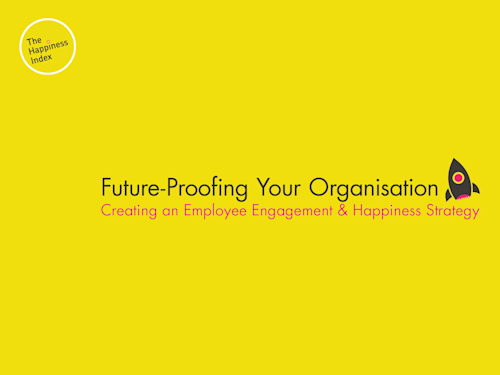
Creating an Employee Engagement AND Happiness Strategy
Whether we’ve personally worked in a toxic workplace, or have friends or family members who have, we all instinctively know what toxic workplace cultures look like. But putting our finger on the definition can be a little harder. How can we identify toxic workplace cultures, and how can we avoid them in our own organisations? Let’s find out…
Difficult, aggressive and distrustful colleagues make us feel uncomfortable in the workplace and can be the face of a toxic workplace. However, this is typically due to bigger underlying structural issues. Lack of accountability, direction, acknowledgement, psychological safety, freedom, and progression and development opportunities are often a root cause for individuals to feel like they can or need to act out in ways that jeopardise relationships.
A phrase that often gets used is “people quit bosses not jobs” but the truth of the matter is more complicated. Certain workplaces and structures breed and enable bad managers, which in turn leads to poor manager/managee relationships, toxic workplaces and, ultimately, high turnover.
A deficit in any of our key neuroscience areas can be involved in creating a negative or toxic workplace. If any of the 8 are severely lacking then this will directly impact overall culture and create negativity that may well manifest itself as a toxic workplace culture.
Of the 8 key themes there are two that are worth looking at in more detail:
Psychological safety is important at work. When people don’t feel safe, their amygdala takes over, putting them into fight or flight mode. This is why you often see confrontational relationships in toxic workplaces (more on that later!). When the amygdala gets activated the brain is put on the back burner. Decision making and creativity are limited, hampering performance.
Workplaces that aren’t sufficiently psychologically safe - where people feel a lack of trust, balance or an unsafe work environment either mentally or physically - will often become toxic.
It’s important to remember that humans are essentially pack or herd animals: our brains have evolved to live in communities. The limbic system, the part of our brain that handles relationships, also deals with survival. Having open, honest and meaningful connections at work is key to our overall happiness.
When positive relationships, either at managerial or at an interpersonal level aren’t available, we start to see toxic workplaces appear.
Both safety and relationships build into the happiness side of our neuroscience model - a good example of why it’s important not to neglect happiness and just focus on engagement.
We often see organisations assume that remote working can negate the issues of toxic workplaces. In fact, working remotely can sometimes mask the appearance of poor relationships, but won’t eliminate the problem entirely.
Recent surveys have shown that many people have seen a reduction in negative behaviours as a result of remote work. 35% had seen a reduction in gossip, 30% saw less yelling and arguing and 28% saw less bullying - just a few of the things to consider. Firstly, have these behaviours been driven underground? Just because things aren’t happening in the open doesn’t mean they’re not present - virtual channels can be harder to monitor. Also, it’s important to note that 36% saw the same amount of gossip and 13% saw more gossip as an example.
That’s why it’s important to think about safety AND relationships together with the remainder of the key neuroscience themes in order to get a holistic picture of your workplace culture.
The best way to avoid toxic workplaces is to keep monitoring the happiness and engagement of your employees. Although you can’t guarantee happiness or engagement remains high at your organisation at all times, you can use your findings as a weather report. Ensuring that your people have the tools, resources and support they need to recover from temporary back slips.
We recommend using our Employee Voice survey so that you can always keep a pulse on what your people are thinking and feeling. In particular, you can use our powerful dashboards to filter for comments including words like bullying and harassment or other concerning behaviours. This will allow you to respond quickly and appropriately if anything concerning comes up. Using our “close the feedback loop” functionality will enable you to address concerns without compromising anonymity if your people prefer.
If you’re concerned about your workplace being negative or toxic, our Cultural Assessment survey is a good place to start. You can also use the data you collect to make sure that none of the 8 neuroscience themes are significantly lacking. Although a lower score in any of the areas doesn’t necessarily mean that you have a toxic workplace, being aware of weaknesses and fixing them can help guard against sliding into more toxic situations.
Lastly, if you have concerns about specific areas of your organisation, in particular the safety and relationships neuroscience themes we discussed above, we can help there too. Our Neuroscience Theme surveys are designed to give you a deep dive into particular themes so you can tease out the unique challenges you are facing. Not only this, but engaging in dialogue with your people will help you to identify action areas which are bespoke to the individuals within your organisation.

Linked to Happiness in our neuroscience methodology... learn more
The Happiness Index helps organisations measure the key employee engagement AND happiness drivers to power their people strategy.
Our unique platform offers the products, insights and tools to shine a light on your cultural health and empower management to drive thriving cultures.
Our neuroscience-based pre-built surveys measure the full employee experience - from onboarding to exit to empower and enable organisations to understand their people and create data-led action plans.
